0.00%

Insights
Artificial Intelligence in advertising: Transforming marketing in 2025
What to know
AI in advertising automates ad buying, targeting, and content creation, with 75% of companies reporting increased customer engagement through AI-powered marketing campaigns
Programmatic advertising powered by AI enables real-time ad placement and optimization, with companies like JPMorgan Chase achieving up to 450% increases in click-through rates
AI-driven personalization allows brands to deliver hyper-targeted content, with platforms analyzing browsing behavior, purchase history, and demographic data for precise audience segmentation
Content generation tools using machine learning create ad copy, images, and videos at scale, reducing production time and costs while maintaining brand consistency
Ethical considerations including data privacy, algorithmic bias, and transparency remain critical challenges as AI adoption accelerates across the advertising industry
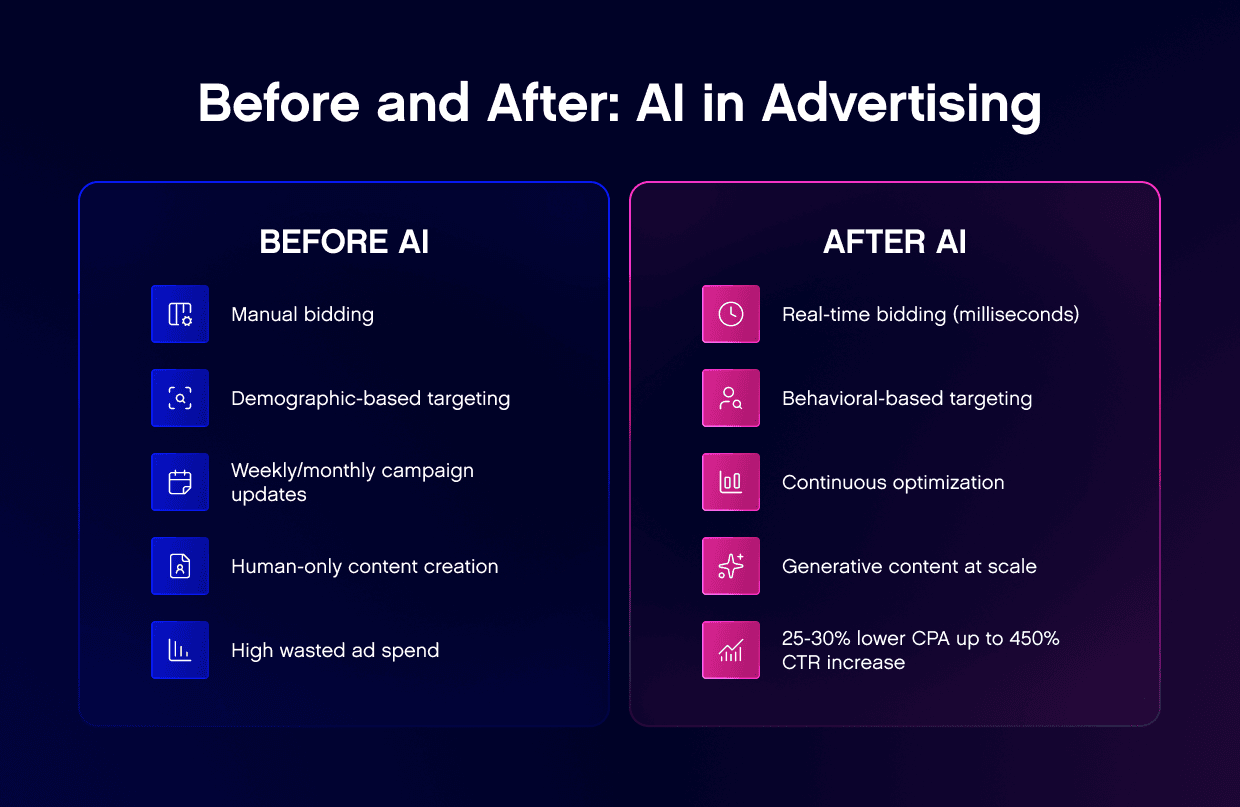
The advertising industry is experiencing a fundamental transformation. Artificial intelligence in advertising has evolved from experimental technology to an essential competitive advantage, with 98% of marketing leaders now leveraging AI for customer engagement according to recent Gartner research. This shift represents more than just technological adoption—it’s reshaping how brands connect with consumers, optimize their advertising budgets, and measure campaign success.
What makes this transformation particularly compelling is the scale and precision AI brings to advertising operations. Where traditional methods relied on broad demographic targeting and manual campaign adjustments, ai systems now analyze vast amounts of consumer data in real time, delivering personalized campaigns that adapt instantly to audience behavior. The result is a new era of advertising efficiency that’s driving measurable business outcomes across industries.
For marketing professionals and business leaders, understanding artificial intelligence in advertising isn’t optional—it’s becoming table stakes for remaining competitive in an increasingly data-driven marketplace. This comprehensive guide explores how AI is revolutionizing every aspect of advertising, from automated content creation to predictive analytics, while providing practical strategies for implementation and addressing the ethical considerations that come with this powerful technology.
Understanding AI in advertising
Artificial intelligence in advertising encompasses a sophisticated ecosystem of technologies designed to automate, optimize, and enhance every aspect of marketing campaigns. At its core, ai in advertising leverages machine learning algorithms to process enormous datasets, identify patterns in consumer behavior, and make intelligent decisions about ad placement, targeting, and content optimization in real time.
The foundation of AI advertising rests on three key technologies. Machine learning enables systems to improve performance automatically by learning from historical data and campaign outcomes. Natural language processing powers the creation of compelling ad copy and enables chatbots to handle customer queries with increasing sophistication. Deep learning, through complex neural networks, drives advanced capabilities like computer vision for video ads and image recognition for ad placement optimization.
Unlike traditional advertising methods that rely on static demographic targeting and scheduled campaign adjustments, AI technologies continuously analyze consumer data patterns to improve targeting precision and campaign performance. While conventional approaches might update campaigns weekly or monthly based on manual analysis, ai systems automatically adjust bidding strategies, audience targeting, and creative elements thousands of times per day based on real-time performance data.
The efficiency gains from AI implementation are substantial. AI-powered personalization in email marketing yields open rates up to 29% higher and click-through rates up to 41% higher than non-personalized alternatives. Moreover, AI eliminates much of the wasted ad spend that plagued traditional advertising by ensuring ads reach the most relevant audiences at optimal times through sophisticated predictive analytics.
For brands looking to remain competitive, the shift toward AI advertising represents both an opportunity and a necessity. The technology’s ability to process vast amounts of data and make split-second optimization decisions creates advantages that manual processes simply cannot match, particularly as consumer expectations for personalized experiences continue to rise.
Digital-first impressions matter more than ever and AI ensures these impressions are optimized for every audience touchpoint.
Core AI applications in digital advertising
The practical applications of artificial intelligence in advertising span across every stage of the customer journey, from initial awareness to conversion and retention. These applications work together to create comprehensive advertising strategies that adapt in real time to maximize effectiveness and efficiency.
Programmatic advertising and real-time bidding
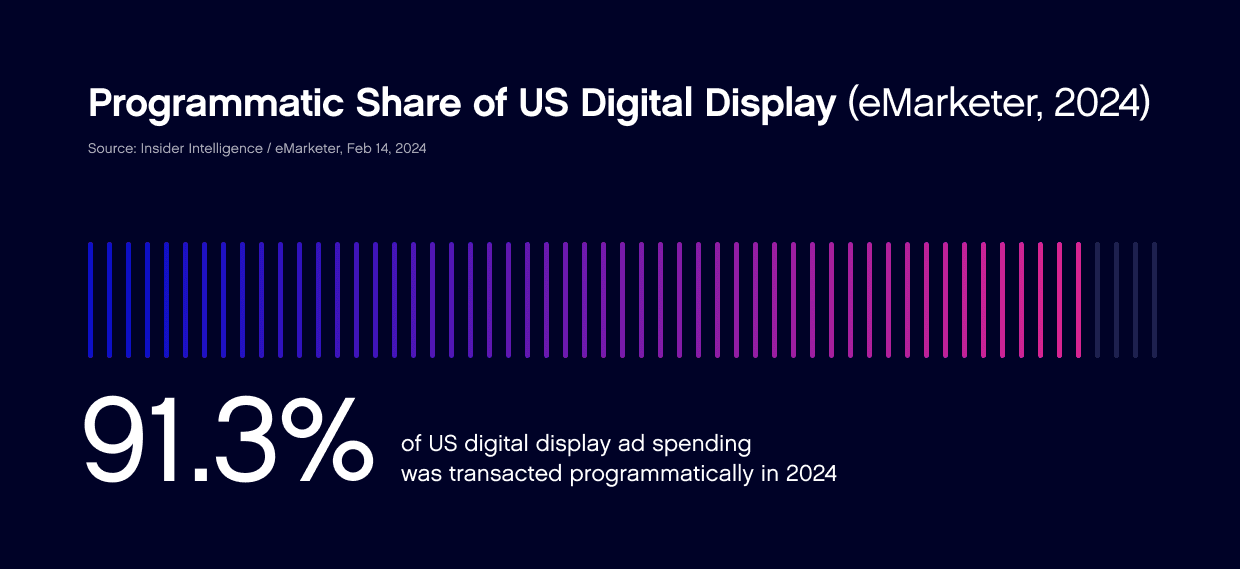
Programmatic advertising represents one of the most successful implementations of AI in the advertising industry, now accounting for over 80% of all digital display ad spend globally. This automated approach uses machine learning algorithms to purchase ad space in real time, making bidding decisions in milliseconds based on audience data, campaign objectives, and predicted conversion likelihood.
The real-time bidding process demonstrates AI’s ability to optimize at scale. When a user visits a website, ai algorithms instantly analyze their browsing behavior, demographic information, and purchase history to determine the value of showing them a particular ad. The system then automatically places bids across multiple ad exchanges, competing with other advertisers to secure the most valuable ad placement opportunities.
Major platforms like Google Ads, Facebook, and The Trade Desk have integrated sophisticated AI systems that continuously optimize campaign performance. Google’s Performance Max, for example, uses machine learning to automatically allocate advertising budgets across the highest-performing audience segments, creative combinations, and placement opportunities without requiring manual intervention from marketers.
The cost reduction and ROI improvements from intelligent bidding strategies are significant. Companies using AI-powered programmatic advertising typically see 25-30% improvements in cost-per-acquisition compared to manual bidding approaches, while simultaneously reaching more relevant audiences through precise targeting algorithms.
Read how creativity and growth intersect when leveraging data-driven tools.
Advanced audience targeting and personalization
AI’s capacity to analyze and segment audiences has revolutionized how brands identify and reach their target audiences. Machine learning algorithms process multiple data points including browsing behavior, purchase history, demographic information, and real-time interaction patterns to create detailed customer profiles that enable hyper-targeted advertising campaigns.
Dynamic audience segmentation powered by AI goes beyond traditional demographic categories to identify niche audiences based on behavioral patterns and consumer preferences. These systems can detect subtle signals that indicate purchase intent, allowing advertisers to reach potential customers at the optimal moment in their decision-making process.
Cross-platform targeting strategies using unified customer data enable brands to deliver consistent, personalized messages across multiple touchpoints. AI systems track individual users across devices and platforms, creating comprehensive profiles that inform targeting decisions on social media platforms, search engines, and display networks simultaneously.
The personalization capabilities extend to real-time content adaptation, where AI systems automatically adjust ad creative, messaging, and offers based on individual user preferences and current context. This level of personalization has proven highly effective, with AI-driven personalized campaigns showing conversion rates up to 25% higher than traditional broad-targeting approaches.
AI-powered content creation and optimization
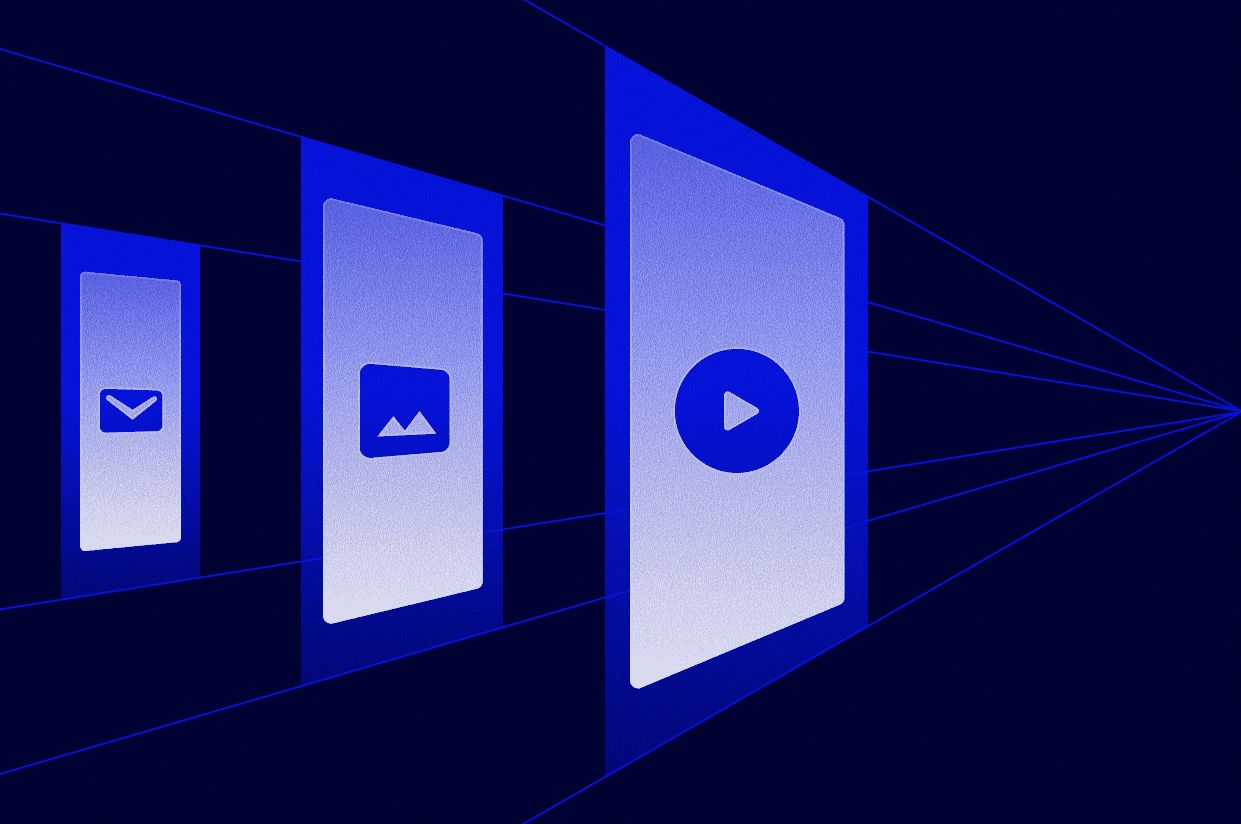
The emergence of generative ai tools has transformed content creation for advertising, enabling brands to produce high-quality ad copy, images, and videos at unprecedented scale and speed. Natural language processing systems can generate compelling headlines, product descriptions, and ad copy that maintains brand voice consistency while adapting to different audiences and platforms.
AI-created visual content includes sophisticated image and video generation capabilities that produce engaging ads tailored to specific campaign objectives. Video generation tools can create personalized video content for different audience segments, dramatically reducing production time and costs while maintaining creative quality.
Dynamic content adaptation represents another significant advancement, where AI systems automatically modify creative elements based on performance data and audience response. A/B testing automation allows brands to continuously experiment with different creative approaches, with machine learning algorithms identifying the most effective combinations and scaling successful variations.
The efficiency gains from AI content creation are substantial. Brands using generative ai tools report reducing content production time by up to 60% while increasing the volume of creative assets they can test and deploy across their advertising campaigns.
Predictive analytics and performance forecasting
Machine learning models excel at predicting customer behavior and campaign performance by analyzing historical data patterns and identifying trends that human analysts might miss. These predictive capabilities enable advertisers to make proactive decisions about budget allocation, audience targeting, and campaign timing.
Lead scoring and conversion probability analysis help brands prioritize their advertising spend toward the most promising prospects. AI systems analyze customer engagement patterns, demographic information, and behavioral signals to assign scores indicating the likelihood of conversion, enabling more efficient resource allocation.
Market trend analysis and demand forecasting provide strategic insights for advertising planning, helping brands anticipate seasonal patterns, emerging opportunities, and potential challenges. Real time insights from AI analysis enable rapid campaign adjustments based on changing market conditions or competitor activities.
The accuracy of AI-powered predictive analytics continues to improve as these systems process more data and refine their algorithms. Companies using predictive analytics for advertising report improved campaign performance and more efficient budget utilization, with some achieving 15-20% improvements in overall marketing ROI.
Industry success stories and case studies
Real-world implementations of artificial intelligence in advertising demonstrate the tangible benefits and transformative potential of these technologies across different industries and company sizes.
These examples mirror the lessons in Wave 1: Creativity Over Scale.
Financial services: JPMorgan Chase’s AI revolution
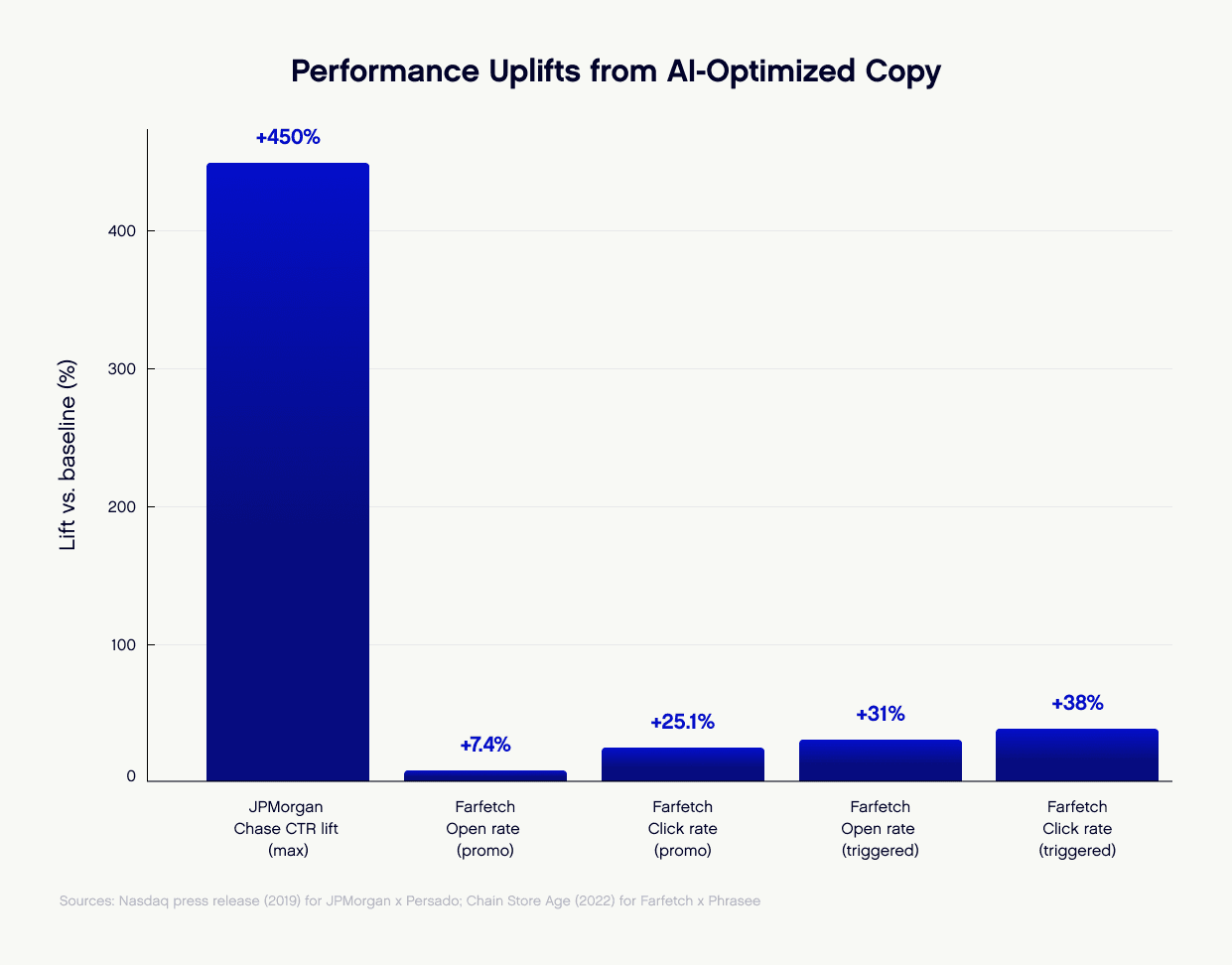
JPMorgan Chase’s partnership with Persado since 2016 showcases how ai tools can dramatically improve advertising performance in the highly regulated financial services sector. The bank implemented AI-generated ad copy to replace traditional human-written marketing messages, focusing on emotional language optimization and personalized messaging.
The results have been remarkable, with the bank achieving a 450% increase in click-through rates through machine learning-optimized messaging compared to traditional copywriting approaches. The AI system analyzes customer data to determine the most persuasive language patterns and emotional triggers for different audience segments.
Looking forward, JPMorgan Chase plans to expand their use of generative ai for creating personalized marketing messages by audience segment, moving beyond general campaigns to individualized communications that resonate with specific customer needs and preferences.
The bank’s success demonstrates how ai advertising can work within strict compliance requirements while delivering measurable improvements in customer engagement and conversion rates across digital marketing channels.
Streaming entertainment: Netflix’s personalization engine
Netflix’s implementation of artificial intelligence represents one of the most sophisticated examples of AI-driven content personalization in the entertainment industry. The company’s algorithms analyze viewing patterns, ratings, and user behavior to deliver hyper-personalized content recommendations to over 230 million subscribers worldwide.
The platform’s Aesthetic Visual Analysis (AVA) system uses computer vision ai algorithms to select optimal thumbnail images for each user based on their viewing history and preferences. This seemingly small optimization has significant impact on user engagement, as the right thumbnail can increase the likelihood of content selection by up to 20%.
Netflix’s machine learning models analyze vast amounts of viewing data to inform not only recommendation algorithms but also content acquisition and production decisions. The company invests billions in original content based partly on AI analysis of viewer preferences and gap identification in their content library.
The platform’s dynamic content curation continuously adapts to user behavior, with the AI system updating recommendations in real time based on viewing sessions, search queries, and engagement patterns. This level of personalization has become a key competitive advantage in the crowded streaming market.
Consumer brands: Coca-Cola’s creative AI integration
Coca-Cola’s partnership with OpenAI through Bain & Company’s global alliance in 2023 demonstrates how established consumer brands can integrate cutting-edge AI technologies into their advertising strategies. The collaboration focuses on leveraging generative ai tools for creative content development and consumer engagement.
The “Create Real Magic” contest exemplified this integration, using ChatGPT and DALL-E to enable user-generated AI art that incorporated Coca-Cola’s brand elements. This campaign successfully merged AI creativity with the company’s rich brand heritage, generating significant consumer engagement and social media buzz.
Beyond consumer-facing campaigns, Coca-Cola is integrating AI-generated content throughout their marketing operations, from initial concept development to final ad copy and visual assets. The company maintains brand voice consistency while dramatically increasing the speed and volume of creative asset production.
The initiative represents a strategic approach to ai use in advertising, where established brands can leverage innovative technologies while preserving the brand equity and emotional connections built over decades of traditional marketing.
E-commerce innovation: Farfetch’s email marketing transformation
Luxury fashion platform Farfetch’s implementation of Phrasee’s generative ai for email marketing optimization demonstrates how ai technologies can improve customer engagement in the competitive e-commerce space. The company replaced traditional email copywriting with AI-generated content optimized for their specific audience.
The results were immediate and substantial: Farfetch achieved a 7% increase in promotional email open rates and an impressive 31% improvement for event-triggered campaigns. Click rates improved by 25% for promotional emails and 38% for triggered email campaigns, demonstrating the power of AI-optimized messaging.
Critically, the AI system maintained Farfetch’s distinctive brand voice while optimizing for performance metrics. The technology learned from the brand’s existing content to generate new email copy that felt authentic to the luxury fashion audience while incorporating persuasive elements that drive engagement.
This case study illustrates how ai advertising tools can be implemented quickly with measurable results, providing a practical roadmap for other e-commerce brands looking to optimize their email marketing performance through artificial intelligence.
Leading AI advertising tools and platforms
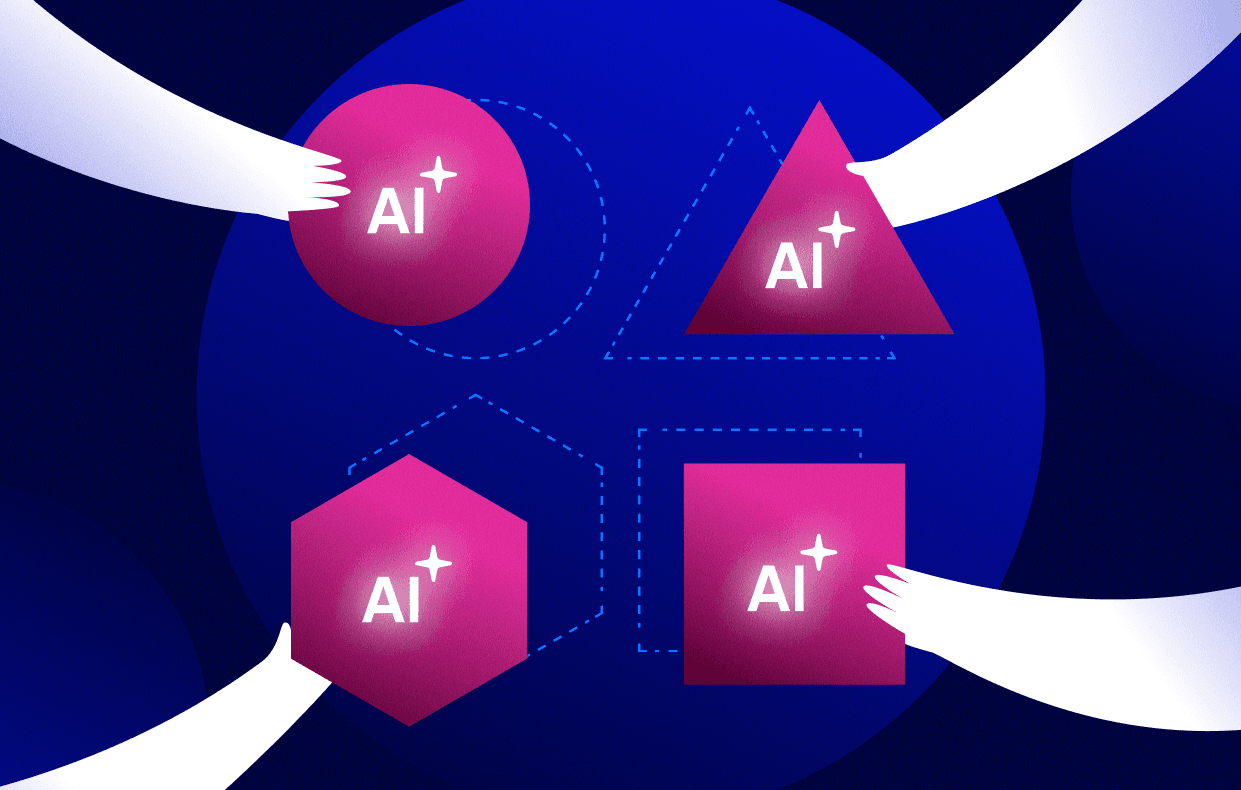
The ai advertising ecosystem includes specialized platforms and tools designed to address different aspects of campaign management, from content creation to performance analytics. Understanding the insights, capabilities, and applications of these tools enables marketers to select the right combination of technologies for their specific needs.
Content generation and creative optimization
Persado leads the market in AI-generated hyper-personalized content, using machine learning to analyze emotional language patterns and create copy that resonates with specific audience segments. The platform’s strength lies in its ability to maintain brand voice while optimizing for conversion across social media platforms and email marketing campaigns.
Omneky specializes in generative ai for visual advertising, creating thousands of optimized ads with precise audience targeting capabilities. The platform combines creative automation with sophisticated targeting algorithms, enabling brands to produce diverse creative assets quickly while ensuring each variation is optimized for its intended audience.
Copy.ai and Jasper have emerged as popular automated copywriting tools, offering solutions for ad copy, social media content, and product descriptions. These platforms excel at generating large volumes of content quickly, though they require human oversight to ensure brand consistency and quality control.
Celtra’s AI-powered creative automation platform generates thousands of ad variations from single creative assets, automatically adapting format, messaging, and visual elements for different platforms and audiences. This capability is particularly valuable for brands managing campaigns across multiple channels and audience segments.
Analytics and performance intelligence
Pathmatics provides AI-powered competitive intelligence and real-time ad strategy insights, enabling brands to monitor competitor activities and market trends. The platform’s machine learning algorithms analyze advertising patterns across digital channels to provide strategic recommendations for campaign optimization.
Emotiva’s facial analysis technology measures emotional responses and attention to advertisements, providing unique insights into creative effectiveness that traditional metrics cannot capture. This emotional data helps advertisers understand which creative elements resonate most strongly with their target audiences.
Google Analytics Intelligence integrates machine learning-driven insights and automated reporting features, making complex data analysis accessible to marketers without extensive technical backgrounds. The platform identifies trends, anomalies, and opportunities automatically, enabling faster decision-making.
Adobe Sensei serves as a comprehensive AI platform for campaign management, predictive modeling, and content optimization. The system integrates across Adobe’s marketing suite to provide unified insights and automated optimizations that improve campaign performance across multiple touchpoints.
Specialized advertising solutions
OneScreen applies machine learning optimization to out-of-home advertising delivery and measurement, bringing digital-style targeting and optimization to traditional outdoor advertising formats. The platform demonstrates how ai technologies can enhance even traditional advertising channels.
GumGum’s computer vision AI analyzes images and videos for optimal ad placement, ensuring contextual relevance between ad content and surrounding media. This technology is particularly valuable for display advertising and social media campaigns where visual context matters.
Amazon Personalize offers a real-time recommendation engine for content personalization and user engagement, providing e-commerce brands with sophisticated personalization capabilities similar to Amazon’s own platform. The tool integrates easily with existing websites and applications.
AiAdvertising combines human expertise with automated optimization, offering AI-powered agency services that maintain strategic oversight while leveraging machine learning for campaign execution. This hybrid approach appeals to brands wanting AI benefits without completely automating their advertising operations.
Implementation strategies for AI advertising
Successfully implementing artificial intelligence in advertising requires strategic planning, proper data foundation, and systematic approach to testing and optimization. The most effective implementations begin with clear objectives and gradually expand AI capabilities as teams gain experience and confidence.
Getting started with AI advertising tools
The first step involves assessing current advertising processes to identify automation opportunities and efficiency gains. Focus on repetitive tasks like bid management, audience targeting, and basic content creation where AI can provide immediate value while freeing human resources for strategic work.
Selection criteria for ai tools should consider business objectives, technical requirements, and integration capabilities with existing marketing technology stacks. Start with tools that address your most significant pain points, whether that’s content creation, audience targeting, or campaign optimization.
Pilot program development enables testing AI capabilities with limited scope and clear success metrics before full-scale implementation. Choose one campaign type or channel for initial testing, establish baseline performance metrics, and set specific goals for improvement through AI implementation.
Integration planning ensures new AI tools work effectively with existing data sources, marketing platforms, and reporting systems. Consider data flow requirements, API capabilities, and staff training needs when selecting and implementing new technologies.
Data strategy and quality management
First-party data collection and organization forms the foundation for effective AI training and optimization. Focus on capturing customer interactions, preferences, and behaviors across all touchpoints to provide ai systems with comprehensive data for analysis and prediction.
Data quality standards ensure accurate AI outputs and reliable campaign performance by establishing processes for data cleaning, validation, and regular auditing. Poor data quality can significantly impact AI performance, making data management a critical success factor.
Privacy compliance frameworks including GDPR, CCPA, and emerging data protection regulations must be integrated into AI implementation from the beginning. Ensure all data collection, processing, and usage practices meet current and anticipated regulatory requirements.
Read how to avoid hidden UX debt when integrating AI.
Cross-platform data integration creates unified customer views that enable consistent messaging and more effective targeting across channels. Invest in data management platforms or customer data platforms that can consolidate information from multiple sources for AI analysis.
Performance measurement and optimization
KPI frameworks for measuring AI advertising effectiveness should extend beyond traditional metrics to include efficiency gains, automation benefits, and improvements in targeting accuracy. Track both performance improvements and operational efficiencies to calculate comprehensive ROI.
Continuous testing methodologies ensure ai systems continue improving over time through systematic experimentation with new algorithms, data sources, and optimization approaches. Implement regular testing schedules and clear processes for evaluating and implementing improvements.
Budget allocation optimization using AI insights requires balancing automated decisions with strategic oversight. Establish guardrails and approval processes for significant budget reallocations while allowing AI systems to make tactical adjustments within defined parameters.
ROI calculation should include AI tool costs, efficiency gains, and improved campaign performance to provide comprehensive understanding of AI investment value. Consider both direct performance improvements and indirect benefits like time savings and improved decision-making speed.
Challenges and ethical considerations
While artificial intelligence in advertising offers significant benefits, implementation brings important challenges that require careful consideration and proactive management. Understanding these challenges enables better planning and more responsible AI deployment.
Data privacy and security concerns
Consumer data protection requirements and transparency in ai-driven advertising practices have become critical considerations as regulations evolve and consumer awareness increases. Brands must clearly communicate how they collect, use, and protect customer data while ensuring AI systems operate within legal boundaries.
Consent management systems ensuring compliant data collection and usage require robust infrastructure and clear processes for obtaining, tracking, and honoring consumer consent preferences. This includes providing easy mechanisms for consumers to understand and control how their data is used for advertising purposes.
Data security measures protecting consumer information from breaches and unauthorized access must be built into AI systems from the ground up. This includes encryption, access controls, and regular security audits to protect the vast amounts of consumer data that power AI advertising algorithms.
The impact of third-party cookie deprecation creates challenges for AI targeting capabilities, forcing advertisers to develop alternative data strategies focused on first-party data and privacy-compliant targeting methods. This shift requires investment in new data collection and management approaches.
Algorithmic bias and fairness
Sources of bias in AI advertising systems can emerge from training data, algorithm design, or historical patterns that reflect societal inequalities. These biases can result in discriminatory advertising practices that exclude certain groups or reinforce harmful stereotypes.
Regular audit processes for identifying and correcting discriminatory advertising practices should include systematic review of targeting patterns, ad delivery, and performance across different demographic groups. Establish clear protocols for addressing bias when it’s discovered.
Diverse data sets and inclusive testing help ensure fair representation across demographics and reduce the likelihood of biased outcomes. This includes testing ai systems across different population groups and adjusting algorithms to ensure equitable ad delivery.
Industry standards and best practices for ethical AI implementation in advertising continue evolving, requiring ongoing attention to emerging guidelines and recommendations from industry organizations, regulators, and advocacy groups.
Workforce impact and adaptation
Job displacement risks in entry-level marketing roles and creative positions require proactive management as ai technologies automate routine tasks. Organizations should communicate clearly about AI’s role and provide support for employees whose roles may change.
Reskilling and upskilling programs prepare marketing professionals for AI-augmented workflows by providing training in AI tools, data analysis, and strategic thinking that complements automated capabilities. Invest in employee development to maximize the benefits of human-AI collaboration.
Human-AI collaboration models that maximize creativity while leveraging automation efficiency represent the most effective approach for most organizations. Focus on using AI to enhance human capabilities rather than replace human judgment and creativity.
New job categories emerging from AI adoption include AI trainers, algorithm auditors, and ethics specialists, creating opportunities for marketing professionals to develop new expertise areas. These roles require combination of marketing knowledge and technical understanding of AI systems.
Future trends and emerging technologies
The rapid pace of AI development continues accelerating, with emerging technologies promising even more sophisticated capabilities for advertising personalization, automation, and effectiveness. Understanding these trends helps advertisers prepare for the next phase of AI evolution.
See also Wave 2: Artificial Benevolence for emerging AI perspectives.
Advanced personalization and hyper-targeting
AI-driven individual-level personalization using real-time behavioral signals and preferences will enable advertising experiences tailored to each consumer’s immediate context and needs. This goes beyond demographic targeting to consider current mood, situation, and intent.
Voice search optimization and conversational AI integration in advertising strategies become increasingly important as smart speakers and voice assistants proliferate. Brands must adapt their messaging and targeting approaches for voice-based interactions and audio advertising formats.
Augmented reality (AR) and virtual reality (VR) advertising enhanced by AI targeting creates immersive brand experiences that adapt in real time to user behavior and preferences. These technologies enable new forms of interactive advertising that blur the lines between content and commerce.
Cross-device tracking and unified customer journey orchestration using machine learning enables seamless experiences as consumers move between devices and platforms. AI systems will better understand and predict customer behavior across the entire digital ecosystem.
Generative AI and creative automation
Advanced video generation tools creating personalized video content at scale represent the next frontier in AI content creation. These systems will produce high-quality video ads tailored to individual viewers or micro-segments, dramatically expanding personalization possibilities.
AI-powered creative strategy development and concept generation for advertising campaigns will evolve beyond execution to include strategic creative thinking. These systems may suggest campaign themes, brand positioning, and creative directions based on market analysis and consumer insights.
Dynamic creative optimization adapting ad content in real-time based on performance data will become more sophisticated, making thousands of creative adjustments per second to maximize engagement and conversion rates for each individual interaction.
Multi-modal AI systems combining text, image, and video generation will create comprehensive campaigns that maintain consistency across all creative elements while adapting each component for optimal performance across different channels and audiences.
Predictive analytics and market intelligence
Advanced demand forecasting using AI analysis of market trends and consumer behavior will help advertisers anticipate opportunities and challenges before they become apparent through traditional market research methods.
Real-time competitive intelligence and automated response strategies will enable brands to react instantly to competitor activities, market changes, and emerging trends. AI systems will monitor the competitive landscape continuously and recommend strategic responses.
Predictive customer lifetime value modeling will optimize advertising investment by focusing resources on prospects most likely to become valuable long-term customers. This approach maximizes the long-term return on advertising investments.
Market opportunity identification through AI analysis of emerging trends and consumer needs will help brands discover new markets, product opportunities, and positioning strategies before competitors recognize these opportunities.
FAQs
What is the difference between AI and machine learning in advertising? Artificial intelligence is a broader technology category that encompasses machine learning, natural language processing, and computer vision. Machine learning specifically focuses on algorithms that learn from data to improve performance over time. In advertising, machine learning powers specific functions like audience targeting and bid optimization, while AI represents the overall intelligent system that combines multiple technologies to automate and optimize campaigns.
How much does AI advertising cost for small businesses? AI advertising costs vary significantly based on needs and scale. Basic AI tools like automated bidding in Google Ads or Facebook start at no additional cost beyond your ad spend. More sophisticated tools range from $50-$500 monthly for small business solutions, while enterprise-level AI platforms can cost thousands per month. Many small businesses start with free or low-cost ai tools built into major advertising platforms before investing in specialized solutions.
Can AI completely replace human creativity in advertising, or is understanding product-market fit still essential? AI serves as an augmentation tool that enhances human creativity rather than a complete replacement. While AI excels at generating variations, optimizing performance, and personalizing content at scale, human creativity remains essential for strategic thinking, brand positioning, and emotional storytelling. The most successful implementations combine AI efficiency with human insight to create campaigns that are both data-driven and emotionally resonant.
What types of data are most important for AI advertising success? First-party customer data forms the foundation for effective AI advertising, including website behavior, purchase history, email interactions, and customer service contacts. Behavioral analytics showing how customers interact with content and ads provide crucial insights for optimization. Engagement metrics across all touchpoints help AI systems understand what resonates with different audience segments and improve targeting accuracy.
How do I measure ROI from AI advertising investments? ROI measurement should include both direct performance improvements and operational efficiencies. Track traditional metrics like conversion rates, cost-per-acquisition, and return on ad spend, but also measure efficiency gains such as time savings, increased campaign volume, and improved targeting accuracy. Calculate the cost of AI tools against improved performance, reduced manual work, and enhanced scalability to determine comprehensive ROI from AI investments.
Sources:
Gartner Research, AI in Marketing Survey (2024) — Generative AI report by Gartner
McKinsey & Company, The State of AI in 2024 — The State of AI: How organizations are rewiring to capture value
eMarketer, Programmatic Advertising Trends (2024) — Programmatic Advertising Forecast & Ad Tech Trends (H2 2024)
JPMorgan Chase & Persado Case Study (2023) — couldn’t locate a credible public link specifically for that case as described.
Bain & Company – Coca-Cola “Create Real Magic” (2023) — “Create Real Magic” AI platform launch by Coca-Cola

About Matic
We're a B2B transformation agency creating strategic advantage through branding, websites, and digital products.
Closing thoughts
The future of marketing belongs to those who design with intelligence
Matic Digital helps companies do exactly that. Our strategists, technologists, and AI specialists work with your team to design a brand strategy roadmap that transforms insight into action and intelligence into impact.
Ready to unlock the full potential of AI in your marketing operations? Get in touch with us to start shaping your roadmap for 2025 and beyond.


